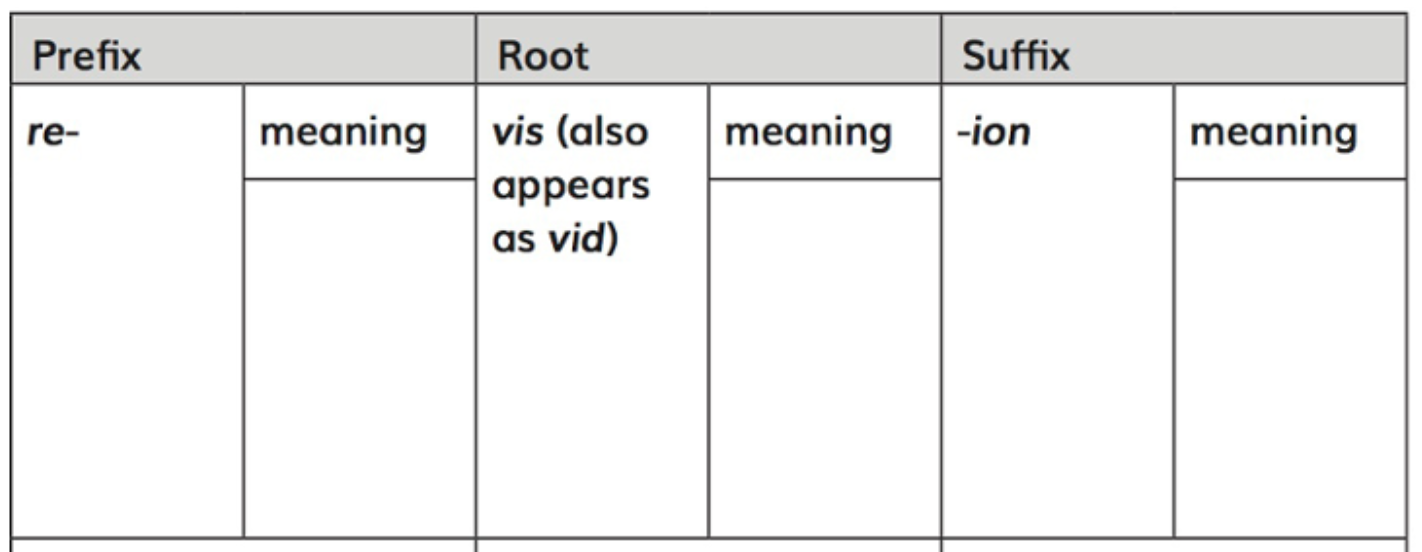Posted in: Aha! Blog > Wit & Wisdom Blog > Science of Reading > Building Vocabulary: Wit & Wisdom's Approach to Morphemic Awareness
This Month’s Focus
The Humanities team at Great Minds® stays updated on the current scientific research on literacy. We bring research to life in our curricula and make research accessible to educators in our blog posts. In this month’s post, Meg Wexler explains how explicit instruction in morphemic awareness helps students implicitly acquire vocabulary in their reading.
Unearthing New Vocabulary in Complex Texts
When I taught Wit & Wisdom® in the classroom, my students came to understand that making meaning of a text is like mining for precious gems. To unlock the text’s meaning, they needed to dig for knowledge by using the skills and strategies we were learning in Wit & Wisdom. Vocabulary shines as one of the most precious gems we uncover in a text. Understanding the words in a text allows students to access the knowledge the text offers. Students also develop lifelong word recognition knowledge that they can apply to new texts they encounter.
Wit & Wisdom intentionally builds vocabulary knowledge through implicit and direct instruction. One form of direct instruction featured in Wit & Wisdom lessons is morphology instruction. Morphology lessons increase students’ morphemic awareness as they learn how morphemes—the smallest units of meaning in language—construct words. As students grow morphemic awareness, they strengthen the Vocabulary strand of Scarborough’s Reading Rope, allowing them to dig deeply into new texts. Students can leverage morphemic awareness to unearth new vocabulary and knowledge from the texts they read.
The Wit & Wisdom Implementation Guide offers two powerful instructional routines to build students’ morphemic awareness.
In Module 1, my Grade 7 students used the Outside-In strategy to unlock the meaning of the word perspective. To find “outside” clues about its meaning, students studied sentences containing the word perspective, such as, “The perspective from the airplane made everything below look tiny.” Next students looked “inside” the word to identify the morphemes per-, spect, and -ive. Then students listed in their Vocabulary Journals words that contain these morphemes. Through discussion, the class landed on a shared definition for the word perspective. After considering the sentences and the root spect, students arrived at the idea that perspective might mean “how we view things."
I luckily observed a Grade 3 colleague showing her students this Morpheme Matrix as a strategy in Module 1:
 Students worked in small groups to list words containing the morphemes re-, vis, and -ion. To determine the definition of revision, students discussed the words they listed under each morpheme to deduce what each morpheme means. Students were able to define the target word, and they strengthened their morphemic awareness by considering other words that contained the targeted morphemes.
Students worked in small groups to list words containing the morphemes re-, vis, and -ion. To determine the definition of revision, students discussed the words they listed under each morpheme to deduce what each morpheme means. Students were able to define the target word, and they strengthened their morphemic awareness by considering other words that contained the targeted morphemes.
Wit & Wisdom lessons in Grades K through 8 use the Outside-In and Morpheme Matrix routines, which means students constantly hone tools like morphemic awareness that can unlock word meanings. When my students encountered unknown words that were not explicitly taught in the module or in their Volume of Reading, I prompted them to use these strategies we had learned to determine the meaning. My seventh graders practiced these strategies and could quickly employ them when needed. I took pride in seeing students engage various strategies unprompted on their assessments, in their independent reading, and even in their other classes.
Summary
Building vocabulary knowledge, like mining, can feel like arduous work. The right tools, such as morphemic awareness, can help students quickly access beautiful gems—new vocabulary and knowledge—that lie within the text.
We would love to hear about the knowledge parties your students have every day in Wit & Wisdom! Connect with us in our Facebook groups for each grade band (K-2, 3-5, and 6-8) or on Twitter @WitWisdomELA.
Submit the Form to Print

Meg Wexler
Meg Wexler is a content developer for Great Minds. In this role, she creates professional learning content to support Wit & Wisdom and Geodes users with successful implementation. Before working at Great Minds, Meg spent 12 years as a middle grades educator in Baltimore City Public Schools and KIPP SoCal Public Schools. Meg holds a master’s degree in education from Johns Hopkins University.
Topics: Science of Reading










